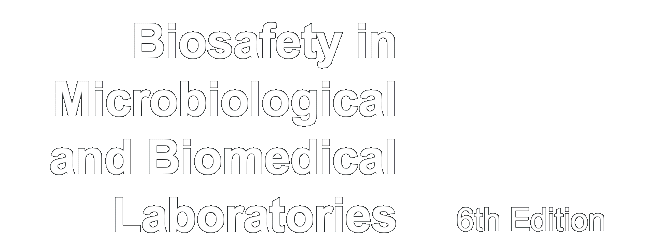Summary of Changes to the Biosafety in Microbiological and Biomedical Laboratories 6th Edition (BMBL-6)
This Summary of Changes was prepared by the ABSA International Technical and Regulatory Review Committee (TRR). May 2021
This Summary of Changes is not to be used as a substitute for the CDC/NIH BMBL-6 edition.
Table of Contents
II: Biological Risk Assessment
IV: Laboratory Biosafety Criteria
Biosafety Level 1 (BSL-1)
Biosafety Level 2 (BSL-2)
Biosafety Level 3 (BSL-3)
Biosafety Level 4 (BSL-4)
V: Vertebrate Animal Biosafety Level Criteria for Vivarium Research Facilities
Animal Biosafety Level 1
Animal Biosafety Level 2
Animal Biosafety Level 3
Animal Biosafety Level 4
VI: Principles of Laboratory Biosecurity
VII: Occupational Health Support for Biomedical Research
VIII-F: Viral Agents Arboviruses and Related Zoonotic Viruses
Appendix B: Decontamination and Disinfection of Laboratory Surfaces and Items
Appendix C: Transportation of Infectious Substances
Appendix E: Arthropod Containment Guidelines
Appendix F: Select Agents and Toxins
Appendix G: Integrated Pest Management
Appendix H: Working with Human, NHP, and Other Mammalian Cells and Tissues
Appendix I: Guidelines for Work with Toxins of Biological Origin
Appendix J: NIH Oversight of Research Involving Recombinant Biosafety Issues
Appendix K: Inactivation and Verification
Section VIII-B: Fungal Agents (pages 212-219)
Section VII-B comprises summaries for fungal agents that include Blastomyces dermatitidis and Blastomyces gilchristii, Coccidioides immitis and Coccidioides posadasii, Histoplasma capsulatum and Sporothrix schenckii species complex. Each agent summary details occupational infections, natural modes of infection, laboratory safety and containment recommendations and any special issues. These agents require an import permit and a domestic transfer permit.
The BMBL-6 removed Cryptococcus neoformans and Dermatophytes agent summaries. Instead a new table, Table 1 Miscellaneous Yeast and Mold, has been added at the end of the section describing occupational and natural mode of infection and the biosafety level for Candida species, Cryptococcus neoformans and C. gattii, Dermatophyte molds, Hyaline molds, Talaromyces marneffei, Dematiaceous molds and Mucormycete molds.
Section VIII-C: Parasitic Agents (pages 223-237)
The BMBL-6 includes the same five subsections of parasites included in BMBL-5. The first two subsections include taxonomically diverse protozoal groups categorized according to lifestyle/ mode of infection. These two subsections include Microsporidia, which are noted actually to be fungi but are grouped with protozoal parasites for historical reasons. The last three categories represent distinct taxonomic groups from the phyla Platyhelminthes (trematodes and cestodes) and Nematoda respectively. A history of LAIs is noted for most subgroups. Known and possible routes of LAIs (e.g. ingestion, percutaneous exposure, arthropod vector bite, etc) are noted for each category. For all parasite groups except nematodes, BSL-2 and ABSL-2 are specifically recommended when handling infective stages; a specific biocontainment level is not recommended for nematode parasites (but BSL-2 / ABSL-2 may be inferred). The need for arthropod containment per Appendix E when infected vector arthropods are present is noted. Specific inactivation procedures using bleach, peroxide, etc are recommended for certain organisms. Special CDC, USDA and/ or DoC permits may be required for importation and shipping for most parasites.
The BMBL-6 includes additional species of Free-Living Amoeba (FLA) and describes the medical conditions associated with FLA, and potential sources of infection in the workplace.
Section VIII-D: Rickettsial Agents (pages 239-244)
This section is in the same order as in the BMBL-5, immediately following Parasitic Agents. All headings found within are also in the same order as the previous edition.
The Rickettsial Agents section begins with Coxiella burnetti, an intracellular pathogen and Select Agent. There is a brief description of C. burnetti followed by the same headers used throughout Section VIII. There are two noticeable modifications to the BMBL-6 from the BMBL-5. First, the header Laboratory Safety and Containment Recommendations now includes a paragraph regarding cell-free media that has been recently developed and more widely disseminated. This header also contains a brief statement regarding a plaque purified clonal strain that is Select Agent exempt and can be used safely following BSL-2 conditions. The second modification to the Coxiella burnetti section is that the mention of a Q-fever vaccine in the IND phase has been removed.
Following C. burnetti, the authors coalesce all other Rickettsia spp. into a single remaining section. There were some minor modifications to this section to reflect newly identified Rickettsial species and safety practices. Specifically, R. philipii and R. parkeri have been added. In terms of the Safety heading, a large paragraph describing BSL-2 with enhanced practices when performing laboratory-based research using Rickettsial species has been added.



